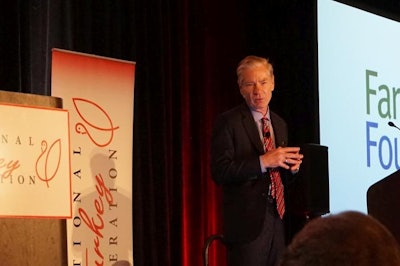
Logic, science and facts aren’t always the strongest factors in decision making for consumer-facing companies. Instead, passion, emotion and feeling can drive major changes that affect the entire food chain.
In his remarks at the National Turkey Federation’s Annual Meeting in San Diego, California, Jerome Lyman, director of Farm Foundation, explained how factors outside of facts and science can affect poultry purchasing decisions of major restaurant chains and food retailers. Lyman, who is retired from McDonald’s Corp., spoke on February 22, 2018. Farm Foundation is a non-partisan agricultural policy institute founded in 1933.
1. Legal requirements
In the past, Lyman explained, the food regulatory laws were the key factors for changing food ingredients, how food is prepared and how it is raised. If a regulation was created, that changed the process.
This is still true, but it’s becoming less important as government is stepping back in the role of regulating the food supply. Now, the absence of laws and regulations is creating space for actors with a focused agenda – like animal activist groups – to push their own standards, influence consumers and ultimately change policy without changing the law.
2. Shareholder activism
Another tactic sometimes used by groups with focused agendas is applying shareholder pressure. Lyman said the groups will buy some stock in a publicly traded company. With the stock, they attend a shareholder meeting, make noise about their specific issue and ask for a vote about changing the company’s official posture toward an issue.
Often, companies ignore the issue until they realize they must make a decision due to shareholder activism. The decision is whether it’s worth putting up with the noise created by the activism, or if its better to just let the activists get what they want and move on.
“Sometimes the best decision for management is, ‘make this thing go away so I can concentrate … on stuff that really ads shareholder value,’” Lyman said.
3. Public brand noise
Consumers – particularly younger ones – are becoming more conscious of corporate values and demanding corporations to show values that align with their own. Because of this, Lyman said, the public brand’s ideal or mission is becoming more important than being more competitive in the marketplace, creating more innovative products, creating more shareholder value and being more efficient.
With this in mind, companies are forced to make a decision based on how it will affect the noise surrounding their brand. This is done to extinguish possible distractions, or bad consumer sentiment, and get back to the core business.
4. Genuine brand mission
In the same vein, there are companies whose mission truly is – and their value proposition is – aligning to a certain ideal. In the food space, two key examples are Panera Bread Co. and Chipotle Mexican Grill Inc. Lyman said these companies offer a compelling consumer proposition on certain policies in food.
“We may agree or disagree with those policies but I think that their shareholders have affirmed, generally, that’s that where they want those brands to be,” Lyman said. “That’s not to be suspicious of them, that’s not to be judgement of them, it’s to – if you want to sell to them – understand what it is that they’re dealing with.”


















